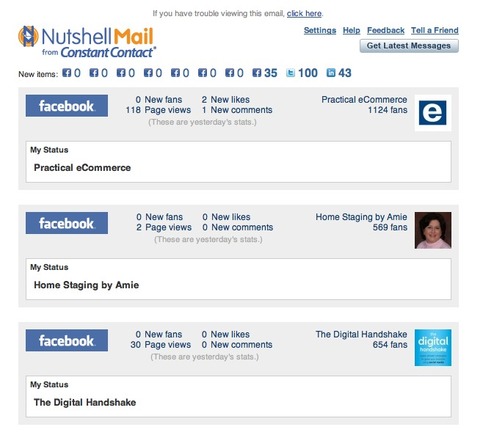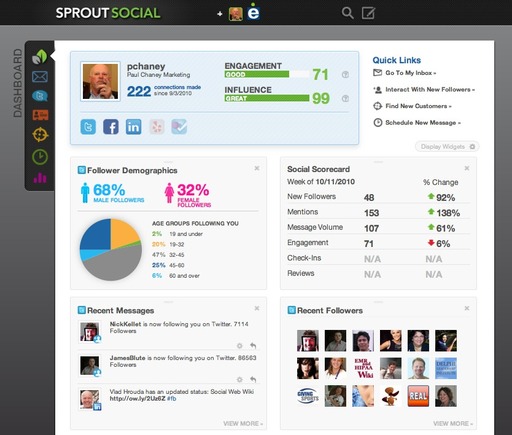A concern I often hear from those new to social networking is the amount of time it takes to manage engagement activities, such as tweeting or posting status updates to Facebook and LinkedIn. While there’s no cost to use these channels, time is valuable and, therefore, the more efficient its utilization, the more cost-effective it becomes.
This article presents five tools that will help you make the most of your social-networking time. You won’t need to use all five, however. I simply want to give you a good selection to choose from.
NutshellMail

Email from NutshellMail.
NutshellMail, from Constant Contact, takes copies of the latest updates in your social networking accounts and places them in a snapshot email which is sent to your primary email address based on a timetable you set. You can receive updates as often as you wish–weekly, daily, or even multiple times per day.
NutshellMail supports Facebook, Twitter, MySpace, LinkedIn and Ning communities. Better yet, it enables you to respond to Twitter @mentions, Facebook messages, and LinkedIn updates directly from the email. And the best part is that it usually only takes 10-15 minutes.
I recommend this tool to those who are casual social networkers. It’s easy and free to use. However, it is primarily designed for reading and responding to updates, not as a platform for content production.
Sprout Social

Sprout Social dashboard.
A tool better suited to power users is Sprout Social, a state of the art social media management and monitoring console. I recently started using this application and I love it. Sprout Social’s organization of content and well-designed user interface makes it one of my favorites for overall management.
Sprout Social’s interface includes six main areas, each of which represents a different set of functions:
- Dashboard. The Dashboard provides a high-level overview of all the latest activity from the various networks and includes a real-time score of ongoing social media engagement and influence efforts.
- Inbox. You can see who’s following you on Twitter, view the latest updates to your social networks feeds, respond to Twitter @mentions and direct messages, as well as Facebook and LinkedIn updates. You can also create posts to submit to any or all of those networks from within the interface.
- Contacts. Search for individual friends, fans or followers in this section.
- Discovery. Using the Discovery section, you can get up-to-the-minute results for keywords searches you create and find Twitter users based on their biographical information. You can also incorporate geo-location, either locally or globally.
- Schedule. The Schedule component enables you to schedule posts for syndication at a later time. You can create one-time posts or recurring messages.
- Statistics. Statistics provides some basic insight into the results of Twitter-posting activity based on the number of retweets for each post.
Aside from a 30-day trial, Spout Social is not free to use. The basic package (called Professional) is available at a very affordable $9.00 per month. That level is intended for individual use, but is suited to the needs of small business, as well. It includes management of up to five different accounts (for example, I use it to manage both my personal and Practical Ecommerce accounts) and supplies users with access to Facebook, Twitter and LinkedIn.
The Business package, designed for larger organizations and agencies, is $49 per month and includes management of up to 10 different accounts. Users at this level can integrate their Yelp and Foursquare accounts, in addition to the networks covered under the Professional package.
Like NutshellMail, Sprout Social also sends a daily email with a digest of updates.

Sprout Social email update.
Even though I prefer not to spend money on software applications when I can avoid it, Sprout Social is worth every penny.
The above tools emphasize content aggregation and filtering. The next three have production as their primary focus.
TweetDeck

TweetDeck interface.
TweetDeck is probably the most popular of all the third-party Twitter applications (see a list of these applications at the Centre for Learning & Performance Technologies) and is certainly the most well known. It is a personal browser for connecting users with their contacts across Twitter, Facebook, LinkedIn, MySpace and other social profiles.
TweetDeck’s interface is arranged in a series of columns so users can see pertinent information at a glance. For instance, I have columns for Twitter @mentions and direct messages on my personal account, as well as columns for status updates to my Facebook and LinkedIn news feeds.
Users can set up groups, save searches and schedule posts to individual social networks and accounts, or in any combination. TweetDeck supports posting of images and video, and can even record video from a webcam directly from the interface. There are also mobile versions of the app for iPhone, iPad and Droid.
Unlike the other applications discussed in this post, TweetDeck is not cloud-based. It has to be downloaded to the user’s computer in order to work. That has been problematic in the past as the software managed memory poorly. But TweetDeck has done a good job of correcting that in recent releases.
TweetDeck is designed for individuals. But the following two applications, HootSuite and CoTweet, work well for organizations.
HootSuite

HootSuite dashboard.
HootSuite shares TweetDeck’s penchant for multiple columns and includes the ability for users to manage different social profiles and accounts. Unlike TweetDeck, however, HootSuite is intended for use by organizations where those assigned can post collaboratively within a team context.
According to HootSuite, there are three types of team members: advanced, basic, and owners. Basic team members can update social networks to which they are assigned, interact with information about social networks and invite other team members. Advanced team members can do anything basic team members can, plus add and remove team members and manage social network account profiles. Owners have complete autonomy over site administration.
HootSuite provides more in-depth statistics than does Sprout Social and can even integrate with Google Analytics. It comes in two versions, Basic, which is free and supports up to five social networks, and Pro, which is $5.99 per month and supports an unlimited number of social networks.
Even though it is designed for corporate use, HootSuite is my tool of choice for posting to my individual accounts. I like the fact that it is web-based, which is the primary reason I prefer it to TweetDeck.
CoTweet

CoTweet inbox.
CoTweet is another content production tool designed for organizational use. Like HootSuite, it facilitates collaborative posting by multiple individuals across different accounts.
CoTweet differs from either HootSuite or TweetDeck in that it does not allow management of social profiles other than Twitter. Also, the interface is set up in a single-column structure. I use this app to manage both our Practical Ecommerce and Ecommerce Developer Twitter accounts.
CoTweet comes in two editions, Standard, which is free, and Enterprise, which starts at $1,500 per month and is designed for use by large organizations. Even though it provides additional features–such as Facebook and Salesforce integration, an iPhone app and in-depth analytics–the Standard edition should suffice for smaller businesses.
Summary
NutshellMail and Sprout Social are designed for content aggregation and overall management of social profiles. TweetDeck, HootSuite and CoTweet are primarily intended for posting to social media networks. For individual use, I recommend a combination of NutshellMail and either TweetDeck or HootSuite. For organizations, I’d suggest Sprout Social and either HootSuite or CoTweet. Try each application to see which best fits your personal tastes. All of the tools listed are “best of breed” in their own category. So you can’t go wrong, no matter which you choose.



